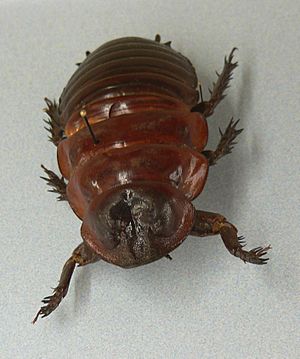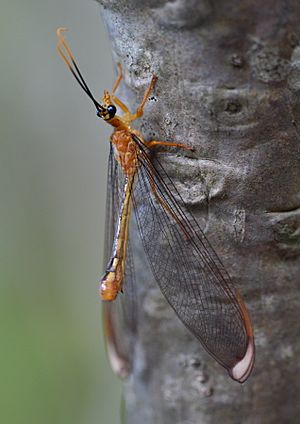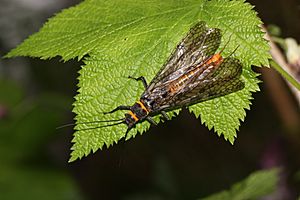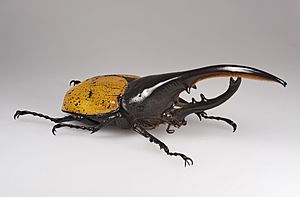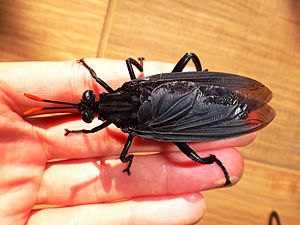List of largest insects facts for kids
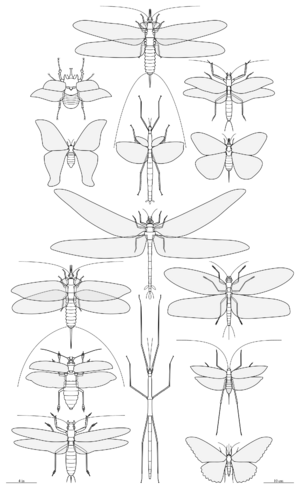
Insects, which are a type of arthropod, are the most numerous group of multicellular organisms on the planet, with over a million species identified so far. The title of heaviest insect in the world has many contenders, the most frequently crowned of which is the larval stage of the goliath beetle, Goliathus goliatus, the maximum size of which is at least 115 g (4.1 oz) and 11.5 cm (4.5 in). The highest confirmed weight of an adult insect is 71 g (2.5 oz) for a giant weta, Deinacrida heteracantha, although it is likely one of the elephant beetles, Megasoma elephas and Megasoma actaeon, or goliath beetles, both of which can commonly exceed 50 g (1.8 oz) and 10 cm (3.9 in), can reach a greater weight.
The longest insects are the stick insects, see below.
Representatives of the extinct dragonfly-like order Meganisoptera (also known as griffinflies) such as the Carboniferous Meganeura monyi and the Permian Meganeuropsis permiana are the largest insect species ever known. These creatures had a wingspan of some 71 cm (28 in). Their maximum body mass is uncertain, with estimates varying between 34 g and 210 g.
Contents
- Dragonflies and damselflies (Odonata)
- Mayflies (Ephemeroptera)
- Palaeodictyoptera (extinct)
- Grasshoppers, crickets, and relatives (Orthoptera)
- Earwigs (Dermaptera)
- Scorpionflies (Mecoptera)
- Stick insects (Phasmatodea)
- Cockroaches and termites (Blattodea)
- Praying mantises (Mantodea)
- True bugs (Hemiptera)
- Dobsonflies and relatives (Megaloptera)
- Net-winged insects (Neuroptera)
- Lice (Phthiraptera)
- Stoneflies (Plecoptera)
- Beetles (Coleoptera)
- Icebugs (Grylloblattodea)
- Ants, bees, and wasps (Hymenoptera)
- Butterflies and moths (Lepidoptera)
- True flies (Diptera)
- Booklice (Psocoptera)
- Fleas (Siphonaptera)
- Thrips (Thysanoptera)
- Caddisflies (Trichoptera)
- Silverfishes and allies (Zygentoma)
- Angel insects (Zoraptera)
- See also
Dragonflies and damselflies (Odonata)
The largest wingspan of any living species of odonate (the order that includes dragonflies and damselflies) belongs to Megaloprepus caerulatus, reaching 19 centimeters (7.5 inches) in wingspan. Petalura ingentissima has the largest wingspan of any dragonfly at 165 mm (6.5 in), although Tetracanthagyna plagiata comes in with a close second of 163 mm (6.4 in).
The largest wing surface area of any living species of odonate belongs to Chlorogomphus papilio, a damselfly.
The longest body length of any living species of odonate belongs to Mecistogaster lucretia with a body length of 155 mm (6.1 in).
The heaviest living species of odonate is probably either Petalura ingentissima or Tetracanthagyna plagiata. However other species such as Anax strenuus and Anotogaster sieboldii and other species in Petalura, Tetracanthagyna, Anax and Anotogaster could also be contenders.
See also the extinct genera Meganeuropsis and Meganeura, although they are not certain to be included in the modern dragonfly order.
Mayflies (Ephemeroptera)
The largest mayflies are members of the genus Proboscidoplocia from Madagascar. These insects can reach a length of 5 cm (2.0 in).
Palaeodictyoptera (extinct)
The largest insect of the order Palaeodictyoptera, Mazothairos enormis from the Carboniferous period, reached a wingspan of about 56 centimeters (22 in).
Grasshoppers, crickets, and relatives (Orthoptera)
Arachnacris katydids and Tropidacris grasshoppers reach up to 12–15 cm (4.7–5.9 in) in length and 23–27.5 cm (9.1–10.8 in) in wingspan, making them the largest by these measurements. The largest Saga and Pseudophyllus bush crickets are only a few centimeters smaller.
The heaviest of this widespread, varied complex of insects is the Little Barrier Island giant weta, Deinacrida heteracantha, of New Zealand; one specimen weighed 71 g (2.5 oz) and measured nearly 10 cm (3.9 in), giving it one of the largest insects weights ever known. These heavyweight insects can be over 9 cm (3.5 in) long.
Titanopterans (Titanoptera) (extinct)
Related to modern orthopterans, Triassic insects of the extinct suborder of Titanoptera surpassed them in size. The wingspan of Gigatitan vulgaris was as large as of 40 centimetres (16 in). Clatrotitan andersoni also reached a huge size, having a forewing of 13.8 centimetres (5.4 in) long.
Earwigs (Dermaptera)
The largest of the earwigs is the Saint Helena earwig (Labidura herculeana), which is up to 8.4 cm (3.3 in) in length. There are no recent records of this species and it is generally considered extinct. The largest certainly living species is the Australian giant earwig (Titanolabis colossea), which is about 5 cm (2.0 in) long.
Scorpionflies (Mecoptera)
The largest scorpionfly, the common scorpionfly (Panorpa communis), can reach a body length of about 30 mm (1.2 in).
Stick insects (Phasmatodea)
The longest known stick insects are also the longest known insects, notably species in the tribe Pharnaciini, but they are generally relatively lightweight because of their slender shape. Female of these stick insects usually reach considerably larger sizes than males of the same species. The longest known is a currently undescribed species of Phryganistria, informally referred to as Phryganistria "chinensis", that was discovered in China in 2014. A wild collected female kept at the Insect Museum of West China in Chengdu was the record holder with a total length, including extended legs, of 62.4 cm (24.6 in), and a body length of 36.1 cm (14.2 in), but it was surpassed by one of its captive bred young that reached 64 cm (25 in) in total length.
Other very large species, formerly believed to be longest but now considered second longest is Phobaeticus chani; a specimen held in the Natural History Museum in London is 56.7 cm (22.3 in) in total length, including extended legs, and it has a body length of 35.7 cm (14.1 in). Females of the Australian Ctenomorpha gargantua have been confirmed at up to 56.5 cm (22.2 in) in total length (including extended legs and cerci, the latter of which are unusually long in this species); one captive individual was measured at 61.5 cm (24.2 in), but that size remains unconfirmed. Another very large species is Phobaeticus kirbyi where the total length (including extended legs) is up to 54.6 cm (21.5 in) and the body alone up to 32.8 cm (12.9 in). Another of the longest insect in terms of total length is Phobaeticus serratipes of Malaysia and Singapore, measuring up to 55.5 cm (21.9 in) in total length.
The spiny stick insect (Heteropteryx dilatata) of Southeast Asia does not reach the extreme lengths of its cousins, the body reaching up to 16 cm (6.3 in) long, but it is much bulkier. The largest Heteropteryx weighed about 65 g (2.3 oz) and was 3.5 cm (1.4 in) wide across the thickest part of the body.
Cockroaches and termites (Blattodea)
The largest cockroach in length and wingspan is the South American Megaloblatta longipennis, at up to 9.7 cm (3.8 in) and 18–20 cm (7.1–7.9 in), respectively. Other contenders for longest are Blaberus giganteus, which is found in the same general region and may reach a length of up to 9 or 10 cm (3.5 or 3.9 in), depending on source, and Princisia vanwaerebeki of Madagascar, which grows between 5.6 and 10 cm in length. The heaviest is the Australian giant burrowing cockroach (Macropanesthia rhinoceros), which can attain a length of 8.4 cm (3.3 in) and a weight of 33.5 g (1.18 oz).
Termites
The largest of the termites is the African species Macrotermes bellicosus. The queen of this species can attain a length of 10.6 cm (4.2 in) and breadth of 5.5 cm (2.2 in); other adults, however, are about a third of this size.
Praying mantises (Mantodea)
The giant stick mantises Toxodera maxima and Ischnomantis gigas can reach lengths of over 17 cm, but are more gracile in build than other large mantises. Other species of Toxodera and Ischnomantis, and other genera of “stick mantises” (Heterochaeta, Solygia and Tauromantis), can attain lengths almost as large (over 16 cm).
Mantises of the tribe Hierodulini (of which Rhombodera fratricida is the largest formally described by science) can reach lengths of nearly 13 cm (5.1 in) and are more robust than comparably sized mantises of other genera (Tenodera, Macromantis, Idolomantis, Sphodromantis, Deroplatys, Plistospilota and Stagmatoptera). Some larger species have been known to capture and consume frogs, lizards, mice, small birds, small fish and even small snakes.
True bugs (Hemiptera)
The heaviest species of this diverse, huge order are the giant water bugs Lethocerus grandis and Lethocerus maximus. These can surpass a length of 12 cm (4.7 in), although they are more slender and less heavy than most other insects of this size (principally the huge beetles).
The largest wingspan of any Hemiptera belongs to the largest species of cicada: Megapomponia imperatoria, which has a head-body length of about 7 cm (2.8 in) and a wingspan of 18–20 cm (7–8 in). The cicadas of the genus Tacua can also grow to comparably large sizes.
The largest total length of any Hemiptera belongs to Gigantometra gigas (the largest species of water strider), which has a leg span of more than 25 cm (9.8 in).
The largest type of aphid is the giant oak aphid (Stomaphis quercus), which can reach an overall length of 2 cm (0.79 in). The biggest species of leafhopper is Ledromorpha planirostris, which can reach a length of 2.8 cm (1.1 in).
Dobsonflies and relatives (Megaloptera)
Megaloptera includes dobsonflies, alderflies and relatives. The largest is the dobsonfly Acanthacorydalis fruhstorferi, which can have a wingspan of up to 21.6 cm (8.5 in), making it the largest aquatic insect in the world by this measurement. This species is native to China and Vietnam, and its body can be up to 10.5 cm (4.1 in) long.
Net-winged insects (Neuroptera)
These flying insects reach their largest size in Palparellus voeltzkowi, which can have a wingspan over 16 cm (6.3 in). The largest lacewing is the Australian "blue eyes lacewing" (Nymphes myrmeleonides), which can measure up to 4 cm (1.6 in) in length and span 11 cm (4.3 in) across the wings. Some forms of this ancient order could grow extremely large during the Jurassic period and may have ranked among the largest insects ever. Found in the Early Cretaceous sedimentary rocks, Makarkinia adamsi had wings nearly 140–160 mm (5.5–6.3 in) in length.
Lice (Phthiraptera)
These parasitic insects are typically modest in size. The largest known species is the hog louse, Haematopinus suis, a sucking louse that lives on large livestock like pigs and cattle. It can range up to 6 mm (0.24 in) in length.
Stoneflies (Plecoptera)
The largest species of stonefly is Pteronarcys californica of western North America, a species favored by fishermen as lures. This species can attain a length of 5 cm (2.0 in) and a wingspan of over 8 cm (3.1 in).
Beetles (Coleoptera)
Beetles constitute the most diverse order of organisms on earth, with about 400,000 species identified to this day. The most massive of them belong to the genera Goliathus, Megasoma, Chalcosoma, Titanus, Macrodontia, and Xixuthrus. The longest is the Hercules beetle, Dynastes hercules, with a maximum overall length of at least 18.1 cm (7.1 in) including the very long pronotal horn. The longest overall beetle is a species of longhorn beetle, Batocera wallacei, from New Guinea, which can attain a length of 26.6 cm (10.5 in), about 19 cm (7.5 in) of which is comprised by the long antennae.
Icebugs (Grylloblattodea)
The largest icebug species, Grylloblatta campodeiformis, 3 cm (1.2 in) long, excluding ovipositors and cerci, and are fairly elongate, wingless insects. They are a uniform honey-yellow in colour and covered with very short hair. Unlike some other species of grylloblatid, G. campodeiformis has eyes which have roughly 70 facets. The head is fairly flat and rounded. The thorax is elongate and over a third of the body length. The abdomen is composed of 10 segments and over half the body length. The legs are long and narrow (cursorial) with stout coxae and long femora. Their antennae are long ~9 mm (0.35 in) and thread-like. In adults, the number of antennal subsegments is variable, ranging from 24 to 27.
Ants, bees, and wasps (Hymenoptera)
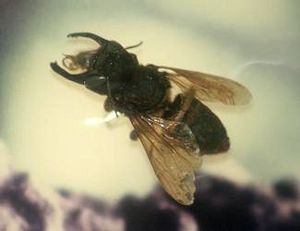
The largest of ants, and the heaviest species of the family, are the queens of Dorylus helvolus, reaching a length of 5 cm (2.0 in). The ant that averages the largest for the mean size of the whole colony is Dinoponera gigantea, averaging up to 3.3 cm (1.3 in). Another ant that is native to Australia, Myrmecia brevinoda, workers are reported to be 3.7 cm (1.5 in) on average and queens are more than 4 cm (1.6 in) in length.
The largest of bees is Megachile pluto, the females of which can be 3.8 cm (1.5 in) long, with a 6.3-cm (2.5-in) wingspan.
The largest wingspan of any wasp is probably the so-called tarantula hawk species Pepsis heros, measuring up to 12.2 cm (4.8 in) in wingspan, although many other Pepsis species approach a similar size and other species of wasp can probably attain greater weights. The heaviest wasp is probably either the giant scoliid wasp Megascolia procer or the largest known social wasp, the queens of the Asian giant hornet (Vespa mandarinia). The former can reach a body length of over 6.5 cm (2.6 in) and a 9.9 cm (3.9 in) wingspan, and the latter a body length exceeding 6 cm (2.4 in) with a 9.3 cm (3.7 in) wingspan.
Butterflies and moths (Lepidoptera)

The largest lepidopteran species overall is often claimed to be either the Queen Alexandra's birdwing (Ornithoptera alexandrae), a butterfly from Papua New Guinea, or the Atlas moth (Attacus atlas), a moth from Southeast Asia. Both of these species can reach a length of 8 cm (3.1 in), a wingspan of 28 cm (11 in) and a weight of 12 g (0.42 oz). One Atlas moth allegedly had a wingspan of 30 cm (12 in) but this measurement was not verified. The larvae in the previous species can weigh up to 58 and 54 g (2.0 and 1.9 oz), respectively. However, the white witch of Central and South America, Thysania agrippina, has the widest recorded wingspan of the order, and indeed of any living insect, at up to 30 cm (12 in). The verified record-sized Thysania spanned 30.8 cm (12.1 in) across the wings, although specimens have been reported to 36 cm (14 in). The largest moth in terms of body mass is the giant wood moth Endoxyla cinereus. Despite having a smaller wingspan than the other species, it has a mass of about 30 g (1.1 oz) and outweighs them all. The Hercules moth (Coscinocera hercules), in the family Saturniidae, is endemic to New Guinea and northern Australia, and its wings have the largest documented surface area (300 square centimeters) of any living insect, and a maximum wingspan which is confirmed to 28 cm (11 in) while unconfirmed specimens have spanned up to 35.5 cm (14.0 in).
True flies (Diptera)
The species with the largest wingspan in this huge order is Gauromydas heros (although some species of Microstylum and Pantophthalmus can attain wingspans almost as large), which can reach a wingspan of 10 cm (3.9 in) and a length of 6 cm (2.4 in). It is also a contender for the longest body length of any true fly, although it is rivaled by Microstylum magnum for this title.
The heaviest flies are undoubtedly the timber flies from the genus Pantophthalmus.
The largest total length of any fly belongs to the largest species of crane fly: Holorusia brobdignagia. If the legs are extended in front of and behind the body, then an overall length of 23 cm (9.1 in) makes it the longest true fly.
Booklice (Psocoptera)
The largest of this order of very small insects is the barklouse of the genus Psocus, the maximum size of which is about 1 cm (0.39 in).
Fleas (Siphonaptera)
The largest species of flea is Hystrichopsylla schefferi. This parasite, known exclusively from the fur of the mountain beaver, can reach a length of 1.2 cm (0.47 in).
Thrips (Thysanoptera)
Members of the genus Phasmothrips are the largest thrips. The maximum size of these species is about 1.3 cm (0.51 in).
Caddisflies (Trichoptera)
The largest of the small, moth-like caddisflies is Eubasilissa maclachlani. This species can range up to 7 cm (2.8 in) across the wings.
Silverfishes and allies (Zygentoma)
These insects, known to feed on human household objects, are up to 1.5 cm (0.59 in) in length. The largest is the extinct Ramsdelepidion schusteri, which reached 6 cm (2.4 in) long.
Angel insects (Zoraptera)
The largest angel insect species, Hubbard's angel insect (Zorotypus hubbardi), grows up to 3 mm (0.12 in) in length.
See also
- Largest prehistoric animals





